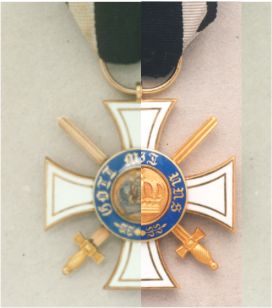|
Some order
decorations are pretty common. Looking at the Kingdom of
Prussia, one will see rather quickly, that there were
uncountable numbers of the Order of the Crown awarded.
Since orders were given for long service, there were
certain officials that couldn't get around being awarded
a certain type and class of order. Especially the Order
of the Crown seems to be used for those purposes.
Everyone collecting Imperial German orders will have a
number of these order decoration in his collection, on a
medal bar or as a single piece.
After reading the first
paragraph one would say, "Not a very interesting piece".
However looking deeper into this topic will bring
variations to the surfaces that are everything than
common. Swords for example were given infrequently, the
Red Cross decorations for 1870/71, the cross attachment
for the members of the order of St. John and the long
service or jubilee numbers.
Definitely
rare are all decorations of the first model, awarded in
the form with the small crown until approx. 1864.
What is the
difference between the first and the second type one
will ask, to make sure he acquires the right piece for
his collection. As easy as that: The small crown.
As easy as that? No. Other details may be easily
overlooked. The cross body follows the "handwriting" of
the jeweler who made a particular decoration. This means
that the Wagner made piece from before 1864 looks
exactly like the cross body made by Wagner after 1864 -
hollow made, scratch mark "W" on the lower cross arm.
The definitive clue is the medallion. The smaller crown
in the first model, of course, is very different in
design than the crown of the second model. A very high
relief and somewhat three-dimensional design was used.
The background of the first model medallion is finer
pebbled than its successor - very fine struck.
|

left
1st model / right 2nd model |
Furthermore the medallion center plate showing the crown
is smaller than that of the second model. The second and
important difference is that the medallion's wreath is
broader and is dark blue enameled.
According to my article
about electroplating I would like to introduce the
reader to a modern fake that I obtained several years
ago - a 2nd Class badge of the first model of the
Prussian Order of The Crown. I will just focus onto the
detail, which made me aware of the fact, that I had
bought this fake. Looking at medallions pictured below,
one will see that the pictured center isn't as fine
struck, as it should be. The medallion wreath also seems
to be the one that should be from a second model, it is
the smaller and light blue enameled.
My first
thought was that perhaps the piece was restored
between 1900 and 1864 using a contemporary medallion
circle (Second model). However I wondered about the
bad quality of the center plate. I took the piece
apart. This was easy because orders are fixed together
using a resin that melts at lower temperature.
Taking
this piece apart, made the answer clear. The Piece was
completely assembled. A cross body and nice but not
good enough made front and back center plates. These
don't really fit into that larger diameter medallion
ring. The close up picture shows in detail the gap on
the medallion plates. Original plates were fixed into
the order in the way, which is shown in the picture
below. The center rim was bent to the middle and
attached from the back. This enabled the jeweler to
fit the center plate like a spring-ring into the
center and used less material. The modern copier
didn't have to care about this, since the material is
cheaper these days than in the 19th century, were the
material was more worthy that the labor someone would
put into assembling an order like this. Needless to
say, that none would have done such a sloppy job on an
order that had to pass the control of the Orders
Chancellery and the jeweler master himself.
Let me say
this again, there is nothing more important than
knowing about the way material was worked on to make
those wonderful order decorations we all collect
today.
© A. Schulze Ising, VI/01
| 




